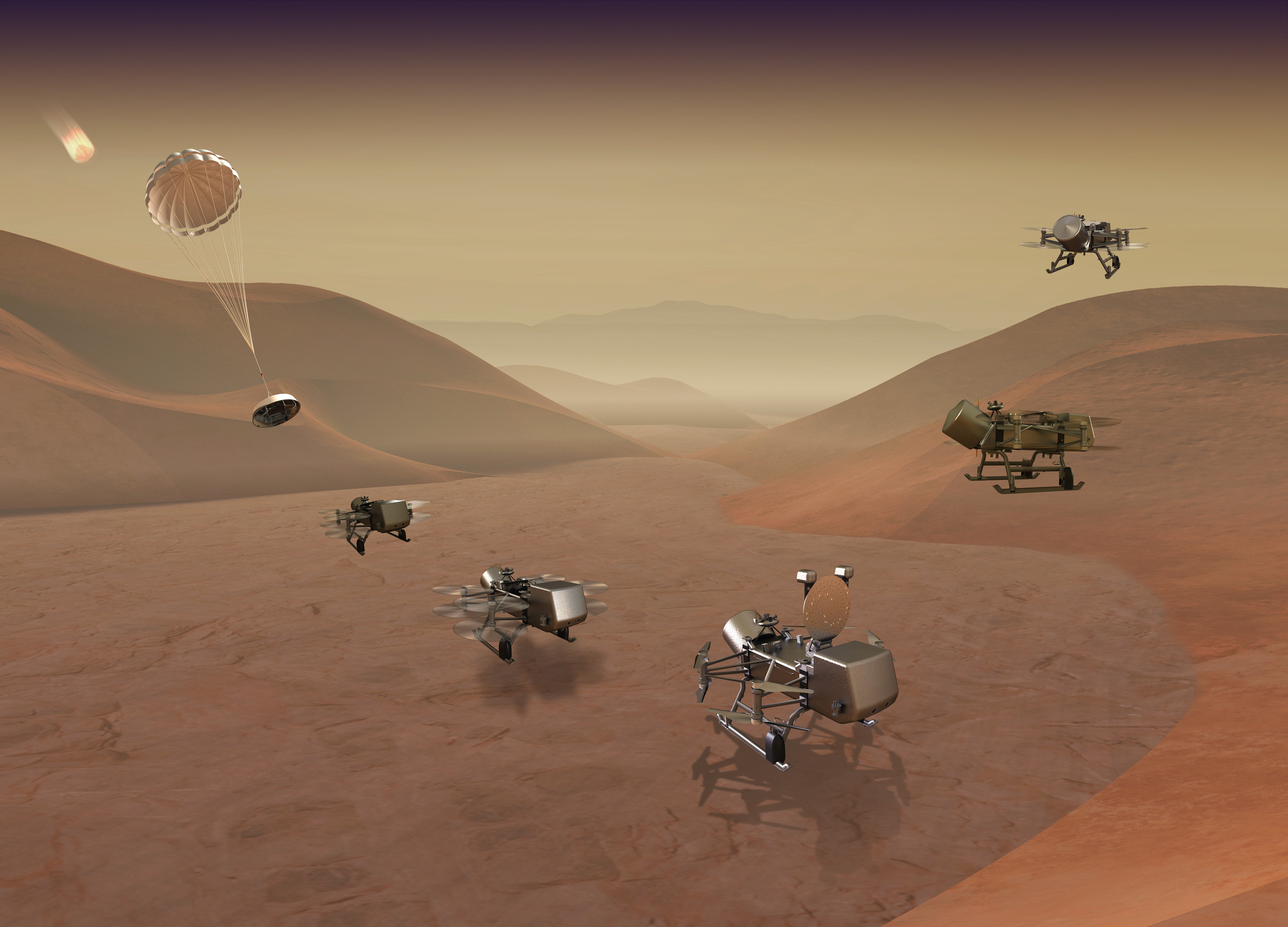NASA announces plans to send a drone to explore Titan for signs of life

NASA selected the next mission in its New Frontiers program today: a drone that will fly on Saturn’s moon Titan in 2034. Dragonfly, as the eight-rotor craft is called, will aim to investigate the distant world’s strange geology—a previous probe glimpsed rivers of liquid methane flowing on the surface—and to search for signs of alien life.
The plan
The idea is for Dragonfly to launch from Earth in 2026, and then zip past Venus and make two flybys of Earth to pick up speed for the long trip to Saturn. Dragonfly won’t enter orbit before heading to the surface—it will be precisely aimed at the edge of the Selk crater, just north of Titan’s equator. Once inside Titan’s thick atmosphere, Dragonfly will drift downward for hours under a series of parachutes until it’s about 1 kilometer above the surface. It will then cut away and fly off in search of a good landing site.
The Tech:
Radio signals take more than an hour to make a one-way trip between Saturn and Earth, which means Dragonfly will have to fly autonomously. NASA officials are confident it can do so reliably because of the remarkable advances in autonomous flight and hazard-detection capability achieved by drones on Earth in recent years. It helps a great deal that Titan has been well scouted by the Cassini mission, which orbited Saturn from 2004 until 2017 and landed a probe on Titan’s surface (the most distant landing ever to take place).
The drone will have eight rotors stacked in four pairs, and will be designed to be able to fly even if one rotor fails. Each rotor will be about a meter long. Because of Titan’s dense atmosphere (over four times denser than Earth’s) and low gravity, it takes only about a 40th as much power to fly there as on Earth. Not that conditions are hospitable in all ways. It will also be cold: about minus 180 °C (minus 290 °F).
The initial landing spot has been carefully chosen. The Selk crater region will be in a direct line of sight from Earth, so Dragonfly will be able to communicate with NASA’s Deep Space Network antennas in California, Spain, and Australia without a relay satellite. That makes the mission both simpler and cheaper. Dragonfly will have a foldable antenna to transmit images and scientific data back to Earth after landing on sand dunes that Zibi Turtle of the Applied Physics Laboratory at Johns Hopkins University, who will head the mission, describes as “the largest Zen gardens in the solar system."
Solar power wouldn’t work well, because of the distance from the sun and Titan’s hazy atmosphere, so Dragonfly will carry a generator that uses heat from the radioactive decay of about 4 kilograms of plutonium to create electricity. That won’t be enough to effectively power the eight rotors, so the generator will charge a battery that will in turn power the drone’s engines.
The initial plan is for a few dozen flights over the course of a bit more than two and a half years. Dragonfly will be able to hop short distances if it lands in an awkward place. But the exploratory flights will be up to five miles each, in a “leapfrog” pattern that will let it scout out good landing sites before committing to them.
The payoff:
Dragonfly will be more than just a joyride—it’s out to settle a number of scientific debates. It will carry a seismometer that can listen for tremors and help determine how thick the ice shell over Titan’s liquid-water ocean is. It will have meteorological instruments and cameras. Cassini also found some evidence that suggests Titan may play host to “cryovolcanoes”—mountains of ice that spew some mixture of water, methane, and ammonia into the atmosphere. Dragonfly will try to figure out whether or not such eruptions indeed happen.
Then there’s the big question: is there now, or has there ever been, life on Titan? Dragonfly will carry a suite of scientific instruments meant to address this question.
One instrument will shoot pulses of neutrons into Titan’s surface to ascertain how much carbon, nitrogen, hydrogen, and oxygen lie below. This pulsed-neutron generator will kick up radiation that will then be detected by two pairs of redundant spectrometers. If those spectrometers find hints of something interesting, two onboard drills will get to work. A sort of vacuum cleaner will suck up the drill cuttings (and other types of samples), which will be examined more closely, especially for purines and pyrimidines—the bases that make up DNA—and for amino acids.
Getting all of these instruments to work reliably in an atmosphere literally dripping with methane will be difficult. But, Turtle says, they are reusing lots of components that have already been functioning on Mars for years. “Titan is a very Earth-like place, despite the fact that the materials are different,” she says. Just how Earth-like? That’s what Dragonfly aims to find out.
Deep Dive
Space
How to safely watch and photograph the total solar eclipse
The solar eclipse this Monday, April 8, will be visible to millions. Here’s how to make the most of your experience.
How scientists are using quantum squeezing to push the limits of their sensors
Fuzziness may rule the quantum realm, but it can be manipulated to our advantage.
The race to fix space-weather forecasting before next big solar storm hits
Solar activity can knock satellites off track, raising the risk of collisions. Scientists are hoping improved atmospheric models will help.
Stay connected
Get the latest updates from
MIT Technology Review
Discover special offers, top stories, upcoming events, and more.